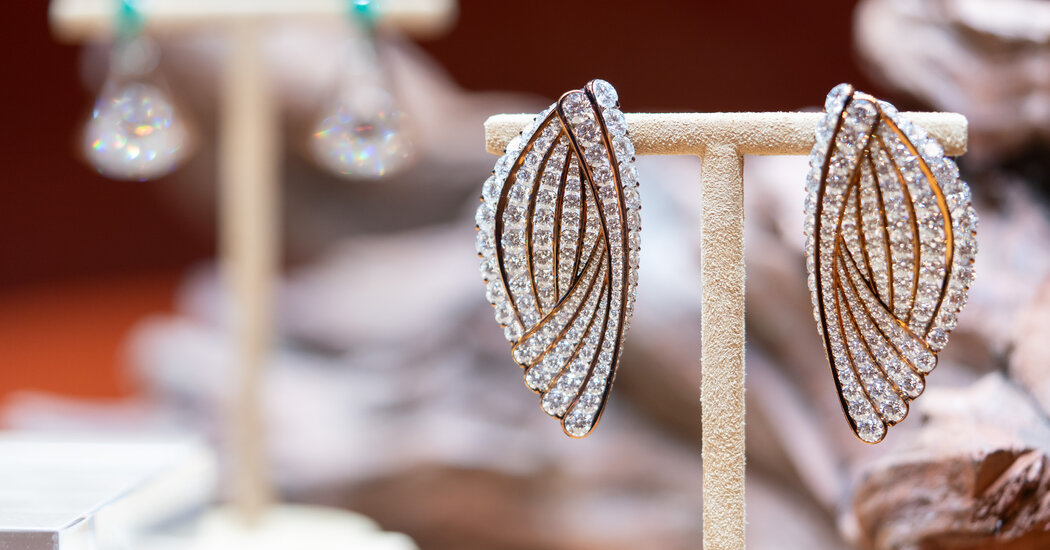Forms isn’t a household name, but the Hong Kong jewelry house is drawing attention for its unusual contemporary style.
A Japanese buckle from the late 19th century inspired the company’s co-founder Tzvika Janover’s latest obsession. The buckle was crafted in a Japanese gold and copper alloy called shakudo, its velvety brown patina unlike anything he’d seen before.
The recipe for shakudo is unknown; each Japanese metalsmith had his own secret recipe. Mr. Janover was determined to recreate it himself, a process that ended up requiring more than a year of experimenting with alloys to achieve what he said was the same rich patina and durability as the original material.
He used the striking yet subtle dark lustrous metal to create a sculpted ring, set with a rare 6.5-carat orange-brown diamond, along with a pair of shakudo earrings, each with an 8-carat green peridot drop and diamond details.
Forms, a jewelry house that sells through its salon in Hong Kong and an office in Geneva, introduced the new pieces at TEFAF, the European Fine Art Foundation fair, in Maastricht, the Netherlands, this past March.
Manon van den Beuken, director of TEFAF Maastricht, said that “TEFAF is all about celebrating craftsmanship and the work of the human hand through the ages, and Forms embodies this spirit perfectly.” She described the pieces as “true works of art.”
The jewelry house draws local and international collectors who come from Europe and the Middle East. With prices starting at $50,000, the jewelry attracts collectors with an appreciation for unique stones and technical prowess, Mr. Janover said.
He established Forms with Elad Assor in 2009, and the house creates no more than 100 pieces per year. Each jewel is different, centered around rare gems and unusual stone cuts, and forged with pioneering techniques and metals such as aluminum, titanium and steel.
The contemporary aesthetic is streamlined, often monochromatic, using complex techniques to set gems side by side without prongs. One such technique, which Mr. Janover calls a “fluid” channel setting, gives the illusion that the stones are floating.
A triangular bright pink ruby, for example, is set flush against a triangular white diamond so they appear as one stone in a purplish-pink aluminum setting. The ring featuring the stones was inspired by the Belgian artist Isabelle Menin’s colorful “Solstice” series of photographs.
A pair of earrings created with willowy lines of blue titanium set with hundreds of diamonds was inspired by the Japanese artist Hiroshi Senju’s waterfall paintings. In another pair of earrings, a couple of pear-shape 3.85-carat Paraiba tourmalines were set in tonal blue aluminum surrounded by marquise-cut diamonds without any visible metal setting to create a light and airy effect.
“Each piece requires lots of passion and patience to craft, which are the most essential qualities we look for in our collaborators in auctions,” said Karen Au Yeung, a senior specialist in Christie’s Asia jewelry department in Hong Kong. Over the past two years, she has offered a few Forms pieces at auction and all have exceeded their pre-sale estimates. In May 2023, a pair of diamond and Burmese ruby earrings resembling pinwheels sold for 1,638,000 Hong Kong dollars ($209,562) above a top estimate of 880,000 Hong Kong dollars.
Rather than create whole collections, Mr. Janover and his team design pieces that “don’t have a certain style,” he said. “We get bored easily, so we are always looking to discover new materials and techniques.”
He collaborates on designs with colleagues: Mr. Assor; Flora Wong, the company director who joined in 2021 from Sotheby’s jewelry department in Hong Kong; and their in-house team of craftspeople.
The heartbeat of the company is the atelier, situated in the company headquarters in the city’s Central district. It runs like a laboratory, where the team researches and tests new ideas. Nikita Travin, the design director and veteran craftsman who joined in 2015, leads a team of about 10 artisans who create pieces from start to finish, beginning with mixing metal alloys and carving stones, then moving on to sculpting pieces and setting gems.
The business partners grew up in families that were in the jewelry industry. Mr. Janover’s family has diamond cutting workshops in Belgium and South Africa and factories in Asia, he said. Mr. Assor was working in marketing and sales for a large diamond company in Asia when they met 20 years ago.
When they established Forms, they initially made lavish red-carpet jewelry for brands and private clients they prefer not to reveal. However, Mr. Janover said, “we didn’t feel connected to these big, massive pieces.”
After a few years, they turned to more experimental pieces.
Their Hong Kong showroom feels like a living room filled with natural light, comfy chairs and a couch.
“They have an intimate relationship with their clients, so we wanted the space to feel like a cozy living room,” explained Yacine Bensalem of In Situ & Partners, the architect who designed the space. He used natural wood contrasted with high-gloss lacquered walls in shades of ruby, emerald and jade. “It is consistent with their jewelry, which uses high polish stones with matte finished metal,” he said.
Perhaps oddly, there is no jewelry on permanent display. Before a client arrives at the by-appointment salon, the Forms team curates a selection for that client, and arranges it on a long dining table.
Mr. Janover gets excited when showing visitors his walk-in vault, which is lined from floor to ceiling with trays of his collection of thousands of stones and artifacts, including antique agate, Baltic amber, dinosaur bones, and Mesopotamian beads.
Since the house showed at TEFAF, Mr. Janover has noticed that more people are inquiring about their jewelry. However, he said, he doesn’t intend to expand production: “Each piece is starting from scratch and that’s the fun of the process.”







